-

人教版高中英语必修3Festivals around the World说课稿3篇
Teaching plan for Unit 1 book3Good morning, teachers. It’s my great pleasure to be here because I can share my lesson with you and I can learn a lot from it. I’ll begin my lesson from the following four parts, the teaching material, the teaching methods, the studying methods and the teaching procedure.Firstly, let me talk about the teaching material. The content of my lesson is the reading passage festivals and celebrations of Unit 1 Festivals around the world. This passage is about festivals and celebrations. By studying this passage, we’ll enable the students to know that festivals exit everywhere, and many of festivals in different countries celebrate similar ideas. As we all know, the reading passage is the center of each unit. If the Ss can learn it well, it will be helpful to make the Ss learn the rest of this unit.After studying the teaching material, I think the teaching aims are as the followings:1. Knowledge aims:(1) The Ss can master the usage of the important words andexpressions.(2)The Ss can use the __________________ (grammar) in the proper situation.Make students know about the festivals all over the world and the detail of the festivals, such as origin, content, and the date of the holiday festivals.2. Ability aims:(1) Students can talk about festivals and celebrations in English(2) To improve the student’s reading ability, especially their skimming and scanning ability.3. Emotion aims:Make the Ss know about the foreign festivals, and respect other countries’ custom.Next, let’s come to the important points and the difficult points.The important point is how to make the Ss understand the text better and the difficult point is how can they talk about it. secondly, Teaching Methods:1. task-based Language Teaching2. Computer assisted language teaching.3. question-and–answer methodThirdly, Studying Methods:

人教版高中英语必修4Theme parks说课稿3篇
The oldest and the most popular park in the worldenjoy the exciting activities thereget close to the life-size cartoon characters like Mickey Mouse and Donald Duck Step 3 Pre-reading1.What do you suppose a theme park is ?2.What do you think you can see in a theme park?(1.It is a kind of amusement park which has a certain theme – that the whole park is based on. 2.buildings, castles, statues, rare animals and birds, and so on.) Step 4 Reading ----- Theme Parks –---- Fun and More Than Fun1.Predict : Read the title and the pictures on P. 34 and PredictWhat is the meaning of the title “Theme Park – Fun and more than fun”?(The title means that theme parks are fun to visit, but that they can also be educational and can offer useful information.)2.Skimming Fast read and answer:What activities can we take in a theme park?Amusement park: Bumper car Merry-go-round slide bungee jumping Free-fall rides Horror films Pirate ship Ferris wheel roller coaster3.Scanning Read again and you will find various theme parks are mentioned in the passage . Then what are they ?Theme parks: Sports theme park History theme park Culture theme park Marine or Ocean theme Park Future park Science theme park Disneyland4.Careful reading and find the main idea of each paragraph:THEME PARKS---- entertaining/ educationalPara.1 Traditional parks are places to go for relaxation and to have time away from our busy lives.Para.2 Theme parks are different They’re large and full of things to do, see and buy.Para.3 Theme parks are built around a single idea or theme. One example is a sports park.Para.4 Another kind of theme park is historical more and cultural and can be educational.Para.5 Disneylandwas the first theme park. It is based on the fantasy life and characters of Disney’s films.Para.6 Some examples of educational theme parks include sea world parks and science parks.

人教版高中英语必修3Healthy Eating说课稿4篇
Language learning needs a context, which can help the learners to understand the language and then can product comprehensible output, so computer has the advantages to make the materials attractive.Part 3 Learning MethodsTask-based, self-dependent and cooperative learningPart 4 Teaching ProcedureStep One Lead-in“Interest is the best teacher.” Therefore, at the very beginning of the class, I should spark the students’ mind to focus on the centre topic “the band”. I’ll show some pictures of food to attract their attention and then bring some questions.Question:What kind of food they like?What should go into a good meal?The answers must relate to the diet. After this, the students will be eager to know something about a balance diet and this is the very time to naturally lead the class into Step 2Step 2 Reading for information: skimming and scanning In this step, I use Task-based Language Teaching method, which can give students a clear and specific purpose while skimming and scanning the context.Task 1 General ideaThe students will be asked to just glance at the title and the pictures of the passage, and then guess what they will read in the text. And they’ll be divided into groups of four to have a discussion.The purpose is to inspire the students to read actively, not passively. In addition, the task is to develop the students’ reading skill by making prediction and to encourage the students to express their thoughts in English and cooperate with each other.Task 2 Main idea of each paragraphCooperative learning can raise the students’ interest and create an atmosphere of achievement. Based on this theory, I divide the whole class into 4 groups to skim the whole text and get the main idea of each paragraph.

人教版高中英语必修4Working The Land说课稿3篇
Knowledge objectives:(1) to make Ss grasp the usage of words, expressions and sentence structures: statistics, struggle, thanks to, rid of, some patterns for persuasion, the “ing” form as subject and object;(2)to use learnt knowledge to persuade sb.Ability objectives:(1) to develop Ss’ reading skills(skimming, scanning, word guessing);(2) to improve Ss’ speaking, communicating and cooperating skills.Emotional objectives:to make Ss know the contribution of Yuan,and learn his spirit and his simple life time.Teaching important and difficult points:(1) some words, expressions and sentence structures mentioned above;(2)the content of the text;(3)training their reading and speaking skills.Teaching methods: CLT, TBLT,QT.Learning strategies: CLS, QLS, TBLS.Teaching procedures:Step 1 lead-in: (1) teacher plays a piece of recent news from CCTV about the harvest of the super hybrid rice, and ask students whether they know Yuan or not, and talk about him and his contribution.(2)Brain storm: let Ss describe Yuan in their minds including his appearance, his living condition and so on.Step 2 fast reading tasks:(1)teacher introduces Yuan and super hybrid rice(2)make Ss read the text as fast as possible with questions. Such as: what’s the general ideaof this passage? What’s Yuan’ dream? (skimming and scanning skill)Step 3 intensive reading tasks(1)let Ss read the text silently, find topic sentence of each paragraph and draw the difficult sentences and the knowledge what they don’t understand.(words guessing)(2)teacher and Ss talk about the important words, expressions and sentences together, and ask Ss to retell the content of the text.(summarizing and paraphrasing)(3)teacher summarize this part.(4) read again following the courseware.

人教版高中英语必修3The million pound bank note说课稿3篇
在接下来的细读环节,我套用了高考对阅读理解的考查方式设置了5个问题,分别为三个推理判断题,一个细节题和一个主旨大意题。学生需要对文章的内容进行分析、归纳、推理、猜测等高级思维活动才能做出正确的回答。【设计意图】这一过程是对学生进行细读的训练,培养学生获取特定信息和挖掘文章深层次信息的能力。第三环节:Intensive-reading (精读) 15′第三个环节精读,既是最重要的环节,也是突破本课重难点的关键。首先,让学生思考剧本中人物看到百万英镑前后的态度发生了怎样的变化。其次,让学生仔细阅读文章,找出可以表现人物态度变化的具体的语言和动作。最后,让学生总结人物的态度发生变化的根本原因是什么,从而引出Money Talks, 供学生思考。【设计意图】通过一系列的活动培养学生学习从人物的语言和动作探究人物的心理,使学生进一步体会戏剧语言的魅力,从而对文章背后所反映的社会问题进行思考,也为下一步的讨论环节做好铺垫。

人教版高中英语必修5First aid说课稿6篇
In this class, I have 3 teaching aims, that is, knowledge aims, ability aims and emotion aims.1) Knowledge-Teach students new words and expressions, such as temporary, bleed,sprain choke, first aid, fall ill and so on.-Enable students to have a better understanding for some basic knowledge of first aid.2) Ability-Train students’ speaking, reading and writing abilities by different teaching activities, such as skimming, comprehending, team work, role play, retelling and writing.-Develop students’ reading strategy on how to move general idea to specific information.3) Emotion-Promote students’ awareness of giving first aid.- Cultivate students’ creativities.Then let’s come to my teaching methods and activities.III. Teaching methods and activities:To achieve different teaching aims, various kinds of teaching methods and activities will be adopted throughout this period, such as TBL (task-based learning), skimming, team work, brainstorm and others, which can offer students opportunities to fulfill tasks in which they can use language to achieve a specific outcome.IV. Teaching aids:Computer and blackboardV. Teaching important points:1) Make students have a clear mind for the structure of the text.2) Help students understand the theme of the text.VI. Teaching difficulties:1) So many new words may affect students’ understanding.2) How to get students to know about the functions of the skin and thecauses, characteristics and treatments for different degree burns,and the knowledge about giving first aid. VII. Blackboard design:

人教版高中英语必修5Great scientists说课稿4篇
通过写文章梗概,培养学生综合运用语言的能力,学习用恰当的英语描述科学家的故事。这是本课的教学难点。教师可以使用完形填空的方式来帮助学生整理语篇,从而来降低难度。本课的教学重点的突破方法是:在阅读前,让学生初步了解得出科学观点所需要的基本程序,从而轻松而自然地导入文章的阅读;在阅读过程中,由易到难设计快速阅读和精读的问题,层层推进各种阅读活动,让学生对阅读内容从整体感知到细节理解,最后深层读懂整篇文章,同时加强阅读策略的指导,让每个学生都主动参与课堂教学活动,最终达到提高阅读能力的目的。Step 4 Post-readingGroup Activities四人小组共同合作,在老师的适当指导下,就以下2个问题展开讨论,让学生就所知、所学、所感和所想融入话题,然后抽若干同学代表作小组发言。1. What do you think about John Snow, and what should we learn from him?2. Cholera was 19th century disease, which two diseases are similar to cholera today? Why?

人教版高中英语必修5Life in the Future说课稿5篇
Good afternoon, everyone. It’s my great pleasure to be here sharing my lesson with you. The content of my lesson is Senior English for China Book5 Unit 3 Life in the Future. I’ll be ready to begin this lesson from six parts: Analysis of the teaching material, Analysis of the students, Teaching aims and important and difficult points, Teaching methods and aids, Teaching procedures, and Blackboard design. First, let me talk about the teaching material.Part 1 Analysis of the Teaching Material:This unit is about what human beings’ life will be like in about one thousand years. By studying of this unit, we’ll Enable the students to know the changes in humans’ life and some new inventions bringing about the change and develop the interest in science. This lesson plays an important part in the English teaching in this unit. This is an important lesson in Book Five. From this lesson, it starts asking the Ss to grasp contents of each passage. Therefore, this lesson is in the important position of the teaching material. If the Ss can learn it well, it will be helpful to make the Ss learn the rest of this unit.Part 2 Analysis of the SsAs Senior2 Ss, they are at different levels of English fluency, some of them have lost interest in English. So during the lesson, I arrange a variety of activities to let all of them join in to attract their interest and let them be confident and taste the joy of success.

人教版高中英语必修5Making the news说课稿4篇
今天我们来介绍一下必修五第四单元的授课方式。这个单元的题目是Making the news。应该是学生比较感兴趣的话题,学生往往对新闻工作充满好奇,所以我们可以利用这个机会多设计一些师生互动和学生互动,来激发起学习的积极性,提高学习效率。同时我们可以利用这个单元不仅帮助学生掌握语言知识,培养语言能力,同时让其了解新闻工作的重要性,培养起社会智能感。这个单元分为六个课时,它的教学目标是这样的:语言目标是掌握词汇表中的常用单词和短语,掌握倒装句的一些基本用法。 技能目标是能初步掌握约会的基本句型并在真实的场景下正确运用。新闻报道类文章的写作技能。采访的基本规范和沟通技能。情感目标是对新闻报道的客观性和真实性有更好的理解。对新闻记者的职业有更深入的了解,并能体会其工作的重要性。下面我们来介绍一下第一课时的授课方式,第一课的教学目标是这样的第一课时的教学目标语言目标:单词:Occupation, journalist, editor, photographer, curious, personality, enthusiasm

人教版高中英语必修5The United Kingdom说课稿4篇
Teaching Aims:Knowledge 1. Get the students to learn the useful new words and expressions in this section. Aims:2. Let the students learn about how the UK was formed and the four groups of invaders.1. Develop students’ reading ability and let them learn different Ability reading skills. Aims:2. Enable students to learn to talk about the United Kingdom and the Union Jack Emotional 1. Let students know more about the UK2. Develop students’ sense of cooperative learning Aims:Teaching Important Points:1. Let the students learn about the countries of the United Kingdom and the Union Jack2. Get the students to read the passage and know about how the UK was formed and the four groups of invaders.3. Have the students learn different reading skills.Teaching Difficult Ponts:1. Develop students’ reading ability.2. Enable students to talk about the United Kingdom and the Union Jack.3. Let students learn how the UK was formed geographically and historically.Teaching Methods:Showing pictures, asking, exercising, listening, reading etc.Teaching Aids:A computer,a projector and a blackboard.Teaching Procedures: 1) Show a map of the world, ask students the following questions:Where is the UK?What’s the full name of the UK?2) Ask the students work in pairs to do the quiz on Page 9.Do you want to test how many things you know about the United Kingdom? Let’s have a small test.Using the map on P9, students answer the following questions:?How many countries does the UK consist of? What are they??England is divided into three main areas. Do you know what they are? 1) Scanning (10Minutes )Let the students hold the questions asked in pre-reading and read the passagequickly and then let them do the following exercise.Join lines to the right answer.
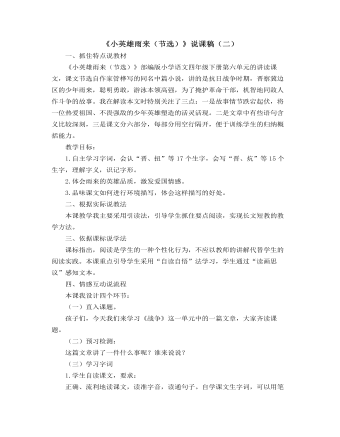
部编人教版四年级下册《小英雄雨来》说课稿(二)
一、抓住特点说教材《小英雄雨来(节选)》部编版小学语文四年级下册第六单元的讲读课文,课文节选自作家管桦写的同名中篇小说,讲的是抗日战争时期,晋察冀边区的少年雨来,聪明勇敢,游泳本领高强,为了掩护革命干部,机智地同敌人作斗争的故事。我在解读本文时特别关注了三点:一是故事情节跌宕起伏,将一位热爱祖国、不畏强敌的少年英雄塑造的活灵活现。二是文章中有些语句含义比较深刻,三是课文分六部分,每部分用空行隔开,便于训练学生的归纳概括能力。教学目标:1.自主学习字词,会认“晋、扭”等17个生字,会写“晋、炕”等15个生字,理解字义,识记字形。2.体会雨来的英雄品质,激发爱国情感。3.品味课文如何进行环境描写,体会这样描写的好处。
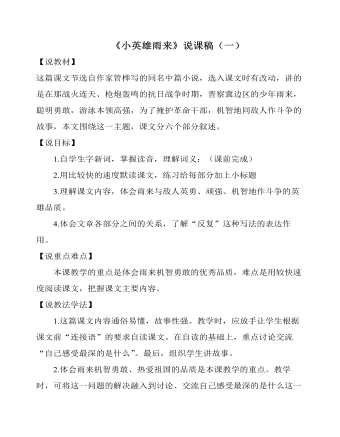
部编人教版四年级下册《小英雄雨来》说课稿(一)
【说教材】这篇课文节选自作家管桦写的同名中篇小说,选入课文时有改动,讲的是在那战火连天、枪炮轰鸣的抗日战争时期,晋察冀边区的少年雨来,聪明勇敢,游泳本领高强,为了掩护革命干部,机智地同敌人作斗争的故事,本文围绕这一主题,课文分六个部分叙述。【说目标】1.自学生字新词,掌握读音,理解词义;(课前完成)2.用比较快的速度默读课文,练习给每部分加上小标题3.理解课文内容,体会雨来与敌人英勇、顽强、机智地作斗争的英雄品质。
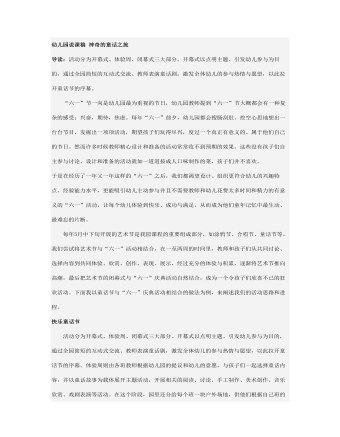
幼儿园说课稿 神奇的童话之旅
“六一”节一向是幼儿园最为重视的节日,幼儿园教师提到“六一”节大概都会有一种复杂的感受:兴奋,期待,焦虑。每年“六一”前夕,幼儿园都会搜肠刮肚、挖空心思地想出一台台节目,发掘出一项项活动,期望孩子们玩得尽兴,度过一个真正有意义的、属于他们自己的节日。然而许多时候教师精心设计和准备的活动常常收不到预期的效果。这些没有孩子们自主参与讨论、设计和准备的活动就如一道道按成人口味制作的菜,孩子们并不喜欢。于是在经历了一年又一年这样的“六一”之后,我们都渴望设计、组织更符合幼儿的兴趣特点、经验能力水平,更能吸引幼儿主动参与并且不需要教师和幼儿花费太多时间和精力的有意义的“六一”活动,让每个幼儿体验到快乐、成功与满足,从而成为他们童年记忆中最生动、最难忘的片断。
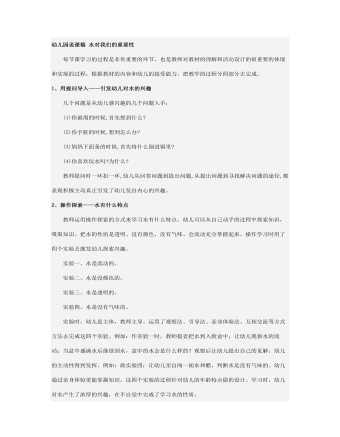
幼儿园说课稿 水对我们的重要性
教师运用操作探索的方式来学习水有什么特点,幼儿可以从自己动手的过程中探索知识,吸取知识。把水的性质是透明、没有颜色、没有气味、会流动充分掌握起来。操作学习时用了四个实验去激发幼儿探索兴趣。 实验一、水是流动的。 实验二、水是没颜色的。 实验三、水是透明的。 实验四、水是没有气味的。 实验时,幼儿是主体,教师主导。运用了观察法、引导法、亲身体验法、互相交流等方式方法去完成这四个实验。例如:作实验一时,教师提壶把水到入脸盆中,让幼儿观察水的流动;当盆中盛满水后继续到水,盆中的水会是什么样的?观察后让幼儿提出自己的见解,幼儿的主动性得到发挥。例如:做实验四:让幼儿亲自闻一闻水和醋,判断水是没有气味的。幼儿通过亲身体验更能掌握知识。这四个实验的过程针对幼儿的年龄特点做的设计。学习时,幼儿对水产生了浓厚的兴趣,在不自觉中完成了学习水的性质。
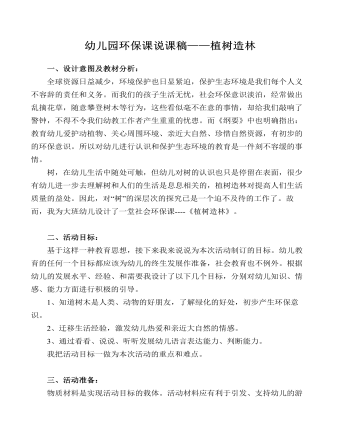
幼儿园环保课说课稿植树造林
二、活动目标: 基于这样一种教育思想,接下来我来说说为本次活动制订的目标。幼儿教育的任何一个目标都应该为幼儿的终生发展作准备,社会教育也不例外。根据幼儿的发展水平、经验、和需要我设计了以下几个目标,分别对幼儿知识、情感、能力方面进行积极的引导。1、知道树木是人类、动物的好朋友,了解绿化的好处,初步产生环保意识。2、迁移生活经验,激发幼儿热爱和亲近大自然的情感。3、通过看看、说说、听听发展幼儿语言表达能力、判断能力。
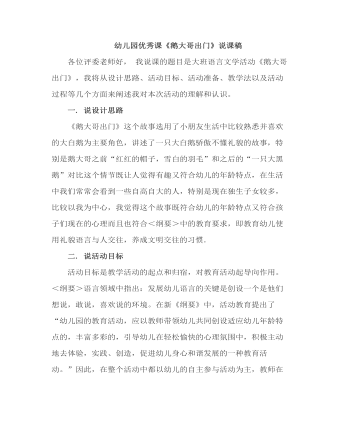
幼儿园优秀课《鹅大哥出门》说课稿
一. 说设计思路 《鹅大哥出门》这个故事选用了小朋友生活中比较熟悉并喜欢的大白鹅为主要角色,讲述了一只大白鹅骄傲不懂礼貌的故事,特别是鹅大哥之前“红红的帽子,雪白的羽毛”和之后的“一只大黑鹅”对比这个情节既让人觉得有趣又符合幼儿的年龄特点,在生活中我们常常会看到一些自高自大的人,特别是现在独生子女较多,比较以我为中心,我觉得这个故事既符合幼儿的年龄特点又符合孩子们现在的心理而且也符合<纲要>中的教育要求,即教育幼儿使用礼貌语言与人交往,养成文明交往的习惯.
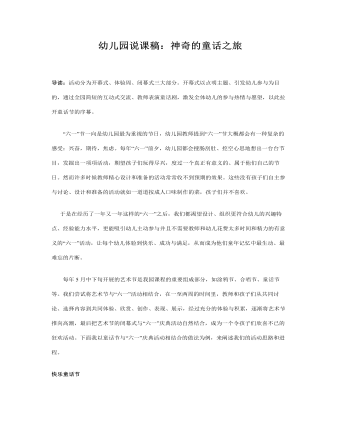
幼儿园说课稿:神奇的童话之旅
“六一”节一向是幼儿园最为重视的节日,幼儿园教师提到“六一”节大概都会有一种复杂的感受:兴奋,期待,焦虑。每年“六一”前夕,幼儿园都会搜肠刮肚、挖空心思地想出一台台节目,发掘出一项项活动,期望孩子们玩得尽兴,度过一个真正有意义的、属于他们自己的节日。然而许多时候教师精心设计和准备的活动常常收不到预期的效果。这些没有孩子们自主参与讨论、设计和准备的活动就如一道道按成人口味制作的菜,孩子们并不喜欢。 于是在经历了一年又一年这样的“六一”之后,我们都渴望设计、组织更符合幼儿的兴趣特点、经验能力水平,更能吸引幼儿主动参与并且不需要教师和幼儿花费太多时间和精力的有意义的“六一”活动,让每个幼儿体验到快乐、成功与满足,从而成为他们童年记忆中最生动、最难忘的片断。 每年5月中下旬开展的艺术节是我园课程的重要组成部分,如涂鸦节、合唱节、童话节等。我们尝试将艺术节与“六一”活动相结合,在一至两周的时间里,教师和孩子们从共同讨论、选择内容到共同体验、欣赏、创作、表现、展示,经过充分的体验与积累,逐渐将艺术节推向高潮,最后把艺术节的闭幕式与“六一”庆典活动自然结合,成为一个令孩子们欣喜不已的狂欢活动。下面我以童话节与“六一”庆典活动相结合的做法为例,来阐述我们的活动思路和进程。快乐童话节 活动分为开幕式、体验周、闭幕式三大部分。开幕式以点明主题、引发幼儿参与为目的,通过全园简短的互动式交流、教师表演童话剧,激发全体幼儿的参与热情与愿望,以此拉开童话节的序幕。体验周则由各班教师根据幼儿园的提议和幼儿的意愿,与孩子们一起选择童话内容,并以童话故事为载体展开主题活动,开展相关的阅读、讨论、手工制作、美术创作、音乐欣赏、戏剧表演等活动。在这个阶段,园里还分给每个班一块户外场地,供他们根据自己班的童话内容进行环境布置,以便在“六一”庆典活动时供全园幼儿活动。闭幕式包括参与体验活动、狂欢活动,将艺术节推向高潮。 对于为期两周的体验周,我们全园教师达成这样一种共识:“六一”活动并非额外的艰巨任务,而是课程的一部分。我们需要做的就是和幼儿一起将童话作品充分展开,并以此为载体推进主题活动。优秀的文学作品往往有丰富的素材和资源可利用,如根据经典童话改编的迪斯尼动画片形象鲜明,语言生动,音乐富于表现力;许多由童话改编而成的图画书文字简洁,适合阅读;还有一些童话剧本也很值得借鉴。 教师可从中挖掘有价值的教育素材,带给幼儿更多的艺术体验。如“狮子王”的主题活动可供选择的素材就非常丰富,在活动中,小狮子辛巴的勇敢坚强、辛巴和娜娜间的友谊成为孩子们交流、讨论的重点。除此之外,非洲草原上丰富的动物种群、独特的非洲音乐都延伸出很多有意义的教育内容。当孩子们发现小狮子辛巴和娜娜成年后具有完全不同的外貌特征时,一个关于动物的性别特征和男孩女孩的话题产生了……就是在这样的过程中,教师不断地给予支持,帮助幼儿体验、享受童话作品中的每一个细节,帮助他们实现一个个设想。

幼儿园说课稿:水对我们的重要性
1、用提问导入——引发幼儿对水的兴趣 几个问题是从幼儿感兴趣的几个问题入手:(1)你最渴的时候,首先想到什么?(2)你手脏的时候,想到怎么办?(3)妈妈下面条的时候,首先将什么倒进锅里?(4)你喜欢玩水吗?为什么? 教师提问时一环扣一环,幼儿从回答问题到提出问题,从提出问题到寻找解决问题的途径,都表现积极主动真正引发了幼儿发自内心的兴趣。2、操作探索——水有什么特点 教师运用操作探索的方式来学习水有什么特点,幼儿可以从自己动手的过程中探索知识,吸取知识。把水的性质是透明、没有颜色、没有气味、会流动充分掌握起来。操作学习时用了四个实验去激发幼儿探索兴趣。 实验一、水是流动的。 实验二、水是没颜色的。 实验三、水是透明的。 实验四、水是没有气味的。 实验时,幼儿是主体,教师主导。运用了观察法、引导法、亲身体验法、互相交流等方式方法去完成这四个实验。例如:作实验一时,教师提壶把水到入脸盆中,让幼儿观察水的流动;当盆中盛满水后继续到水,盆中的水会是什么样的?观察后让幼儿提出自己的见解,幼儿的主动性得到发挥。例如:做实验四:让幼儿亲自闻一闻水和醋,判断水是没有气味的。幼儿通过亲身体验更能掌握知识。这四个实验的过程针对幼儿的年龄特点做的设计。学习时,幼儿对水产生了浓厚的兴趣,在不自觉中完成了学习水的性质,
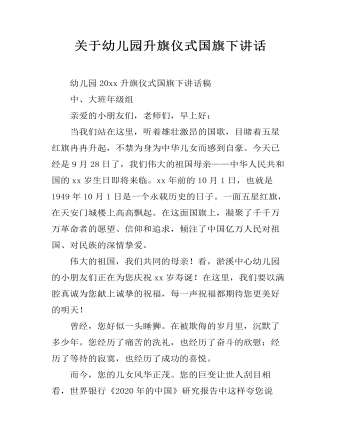
关于幼儿园升旗仪式国旗下讲话
幼儿园20xx升旗仪式国旗下讲话稿中、大班年级组亲爱的小朋友们,老师们,早上好:当我们站在这里,听着雄壮激昂的国歌,目睹着五星红旗冉冉升起,不禁为身为中华儿女而感到自豪。今天已经是9月28日了,我们伟大的祖国母亲——中华人民共和国的xx岁生日即将来临。xx年前的10月1日,也就是1949年10月1日是一个永载历史的日子。一面五星红旗,在天安门城楼上高高飘起。在这面国旗上,凝聚了千千万万革命者的愿望、信仰和追求,倾注了中国亿万人民对祖国、对民族的深情挚爱。伟大的祖国,我们共同的母亲!看,淤溪中心幼儿园的小朋友们正在为您庆祝xx岁寿诞!在这里,我们要以满腔真诚为您献上诚挚的祝福,每一声祝福都期待您更美好的明天!
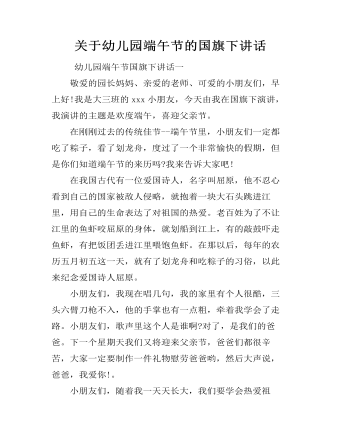
关于幼儿园端午节的国旗下讲话
幼儿园端午节国旗下讲话一敬爱的园长妈妈、亲爱的老师、可爱的小朋友们,早上好!我是大三班的xxx小朋友,今天由我在国旗下演讲,我演讲的主题是欢度端午,喜迎父亲节。在刚刚过去的传统佳节--端午节里,小朋友们一定都吃了粽子,看了划龙舟,度过了一个非常愉快的假期,但是你们知道端午节的来历吗?我来告诉大家吧!在我国古代有一位爱国诗人,名字叫屈原,他不忍心看到自己的国家被敌人侵略,就抱着一块大石头跳进江里,用自己的生命表达了对祖国的热爱。老百姓为了不让江里的鱼虾咬屈原的身体,就划船到江上,有的敲鼓吓走鱼虾,有把饭团丢进江里喂饱鱼虾。在那以后,每年的农历五月初五这一天,就有了划龙舟和吃粽子的习俗,以此来纪念爱国诗人屈原。小朋友们,我现在唱几句,我的家里有个人很酷,三头六臂刀枪不入,他的手掌也有一点粗,牵着我学会了走路。小朋友们,歌声里这个人是谁啊?对了,是我们的爸爸。下一个星期天我们又将迎来父亲节,爸爸们都很辛苦,大家一定要制作一件礼物慰劳爸爸哟,然后大声说,爸爸,我爱你!。

